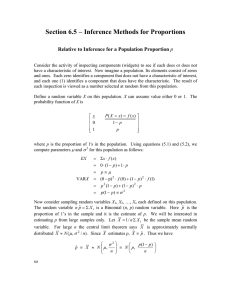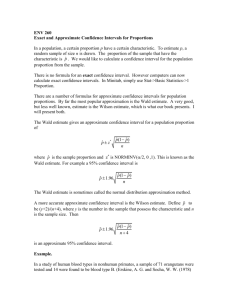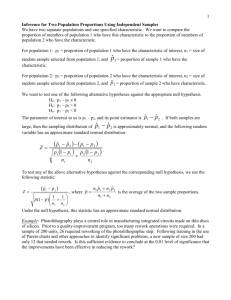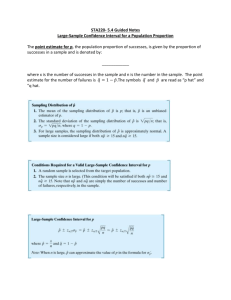Confidence Interval for a Difference of Population Proportions
advertisement
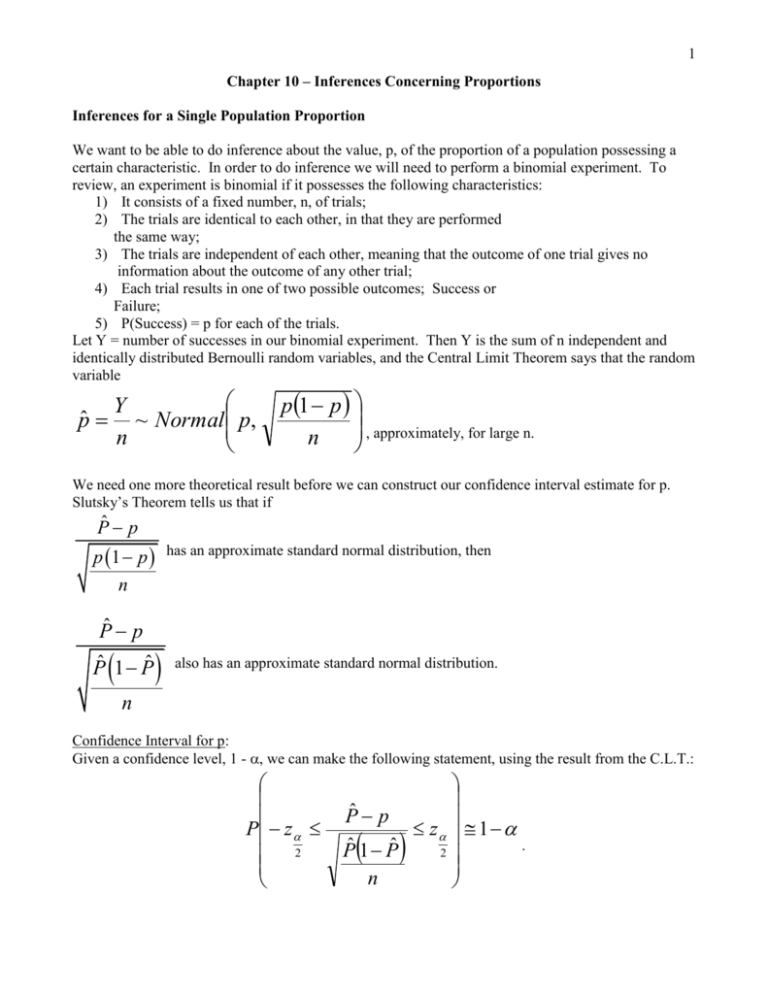
1 Chapter 10 – Inferences Concerning Proportions Inferences for a Single Population Proportion We want to be able to do inference about the value, p, of the proportion of a population possessing a certain characteristic. In order to do inference we will need to perform a binomial experiment. To review, an experiment is binomial if it possesses the following characteristics: 1) It consists of a fixed number, n, of trials; 2) The trials are identical to each other, in that they are performed the same way; 3) The trials are independent of each other, meaning that the outcome of one trial gives no information about the outcome of any other trial; 4) Each trial results in one of two possible outcomes; Success or Failure; 5) P(Success) = p for each of the trials. Let Y = number of successes in our binomial experiment. Then Y is the sum of n independent and identically distributed Bernoulli random variables, and the Central Limit Theorem says that the random variable pˆ Y ~ Normal p, n p1 p , approximately, for large n. n We need one more theoretical result before we can construct our confidence interval estimate for p. Slutsky’s Theorem tells us that if Pˆ p p 1 p n Pˆ p Pˆ 1 Pˆ has an approximate standard normal distribution, then also has an approximate standard normal distribution. n Confidence Interval for p: Given a confidence level, 1 - , we can make the following statement, using the result from the C.L.T.: P z 2 Pˆ p z 1 . Pˆ 1 Pˆ 2 n 2 Rearranging, we obtain: Pˆ 1 Pˆ Pˆ 1 Pˆ ˆ ˆ P P z p P z n n 2 2 Hence an approximate (1 - )100% confidence interval estimate for p is 1 Pˆ z 2 . Pˆ 1 Pˆ n . Example: p. 282, Exercise 10.3 Sample Size for a Specified Margin of Error: As part of our experimental design, we want to specify the margin of error, E, that is acceptable for our estimate of p, and choose a sample size to insure that we achieve this margin of error. We let E z 2 p 1 p n . Solving for n, we obtain z n 2 E 2 p 1 p . Now, we know E and , but we need to find a usable value for p(1-p) before we can find the sample size. We use the fact that for any value of p between 0 and 1, we have p(1-p) 0.25. Then z n 2 E 2 1 4 gives us an upper bound on the sample size that will insure that we will achieve our desired margin of error with confidence level 1 - . Example: p. 283, Exercise 10.11 Testing Hypotheses Concerning a Proportion: We want to test hypotheses of the following possible forms: 1) H0: p = p0 vs. Ha: p p0 2) H0: p p0 vs. Ha: p < p0 3) H0: p p0 vs. Ha: p > p0 The test statistic to be used is Z Pˆ p0 p0 1 p0 n . Under the null hypothesis, the Central Limit Theorem says that this statistic has an approximate standard normal distribution. 3 For the three types of alternative hypotheses, the rejection regions are: 1) Ha: p p0 Reject H0 if |z| > z(/2) 2) Ha: p < p0 Reject H0 if z < -z() 3) Ha: p > p0 Reject H0 if z > z() Example: p. 290, Exercise 10.19 Inference for Two Population Proportions Using Independent Samples We have two separate populations and one specified characteristic. We want to compare the proportion of members of population 1 who have this characteristic to the proportion of members of population 2 who have the characteristic. For population 1: p1 = proportion of population 1 who have the characteristic of interest, n1 = size of random sample selected from population 1, and characteristic. p̂1 = proportion of sample 1 who have the For population 2: p2 = proportion of population 2 who have the characteristic of interest, n2 = size of random sample selected from population 2, and characteristic. p̂ 2 = proportion of sample 2 who have We want to test one of the following alternative hypotheses against the appropriate null hypothesis. Ha: p1 – p2 0 Ha: p1 – p2 > 0 Ha: p1 – p2 < 0 The parameter of interest to us is p1 – p2, and its point estimator is pˆ 1 pˆ 2 . If both samples are pˆ pˆ large, then the sampling distribution of 1 2 is approximately normal, and the following random variable has an approximate standard normal distribution: Z pˆ 1 pˆ 2 p1 p 2 p1 1 p1 p 2 1 p 2 . n1 n2 To test any of the above alternative hypotheses against the corresponding null hypothesis, we use the following statistic: 4 Z pˆ 1 pˆ 2 1 1 p (1 p ) n1 n2 , where p n1 pˆ 1 n2 pˆ 2 n1 n2 is the average of the two sample proportions. Under the null hypothesis, this statistic has an approximate standard normal distribution. Example: Photolithography plays a central role in manufacturing integrated circuits made on thin discs of silicon. Prior to a quality-improvement program, too many rework operations were required. In a sample of 200 units, 26 required reworking of the photolithographic step. Following training in the use of Pareto charts and other approaches to identify significant problems, a new sample of size 200 had only 12 that needed rework. Is this sufficient evidence to conclude at the 0.01 level of significance that the improvements have been effective in reducing the rework? Confidence Interval for a Difference of Population Proportions We want to estimate the difference between the proportion of population 1 who have a characteristic of interest and the proportion of population 2 who have the characteristic. The formula for the (1 – )100% confidence interval is pˆ 1 pˆ 2 z 2 pˆ 1 1 pˆ 1 pˆ 2 1 pˆ 2 . n1 n2 Example: In the previous example, we want an approximate 99% confidence interval estimate of the difference between the proportion of units requiring rework after the improvement program and the proportion of units requiring rework prior to the improvement program.
